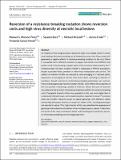Por favor, use este identificador para citar o enlazar a este item:
http://hdl.handle.net/10261/296187COMPARTIR / EXPORTAR:
 SHARE SHARE
 CORE
BASE CORE
BASE
|
|
| Visualizar otros formatos: MARC | Dublin Core | RDF | ORE | MODS | METS | DIDL | DATACITE | |

| Título: | Reversion of a resistance-breaking mutation shows reversion costs and high virus diversity at necrotic local lesions |
Autor: | Moreno-Pérez, Manuel G.; Bera, Sayanta; McLeish, Michael; Fraile, Aurora; García-Arenal, F. | Palabras clave: | Across-host trade-offs Costs of virulence Necrotic local lesions Pepper Tobamovirus Virus diversity |
Fecha de publicación: | feb-2023 | Editor: | Wiley-VCH | Citación: | Molecular Plant Pathology 24(2): 142-153 (2023) | Resumen: | An instance of host range evolution relevant to plant virus disease control is resistance breaking. Resistance breaking can be hindered by across-host fitness trade-offs generated by negative effects of resistance-breaking mutations on the virus fitness in susceptible hosts. Different mutations in pepper mild mottle virus (PMMoV) coat protein result in the breaking in pepper plants of the resistance determined by the L3 resistance allele. Of these, mutation M138N is widespread in PMMoV populations, despite associated fitness penalties in within-host multiplication and survival. The stability of mutation M138N was analysed by serial passaging in L3 resistant plants. Appearance on passaging of necrotic local lesions (NLL), indicating an effective L3 resistance, showed reversion to nonresistance-breaking phenotypes was common. Most revertant genotypes had the mutation N138K, which affects the properties of the virus particle, introducing a penalty of reversion. Hence, the costs of reversion may determine the evolution of resistance-breaking in addition to resistance-breaking costs. The genetic diversity of the virus population in NLL was much higher than in systemically infected tissues, and included mutations reported to break L3 resistance other than M138N. Infectivity assays on pepper genotypes with different L alleles showed high phenotypic diversity in respect to L alleles in NLL, including phenotypes not reported in nature. Thus, high diversity at NLL may potentiate the appearance of genotypes that enable the colonization of new host genotypes or species. Collectively, the results of this study contribute to better understanding the evolutionary dynamics of resistance breaking and host-range expansions. | Descripción: | 12 Pág. | Versión del editor: | https://dx.doi.org/10.1111/mpp.13281 | URI: | http://hdl.handle.net/10261/296187 | DOI: | 10.1111/mpp.13281 | ISSN: | 1464-6722 | E-ISSN: | 1364-3703 |
| Aparece en las colecciones: | (INIA) Artículos |
Ficheros en este ítem:
| Fichero | Descripción | Tamaño | Formato | |
|---|---|---|---|---|
| Reversion-resistance‐breaking mutation.pdf | artículo | 1,61 MB | Adobe PDF |  Visualizar/Abrir |
CORE Recommender
PubMed Central
Citations
1
checked on 21-abr-2024
SCOPUSTM
Citations
2
checked on 24-abr-2024
WEB OF SCIENCETM
Citations
2
checked on 26-feb-2024
Page view(s)
19
checked on 27-abr-2024
Download(s)
32
checked on 27-abr-2024

